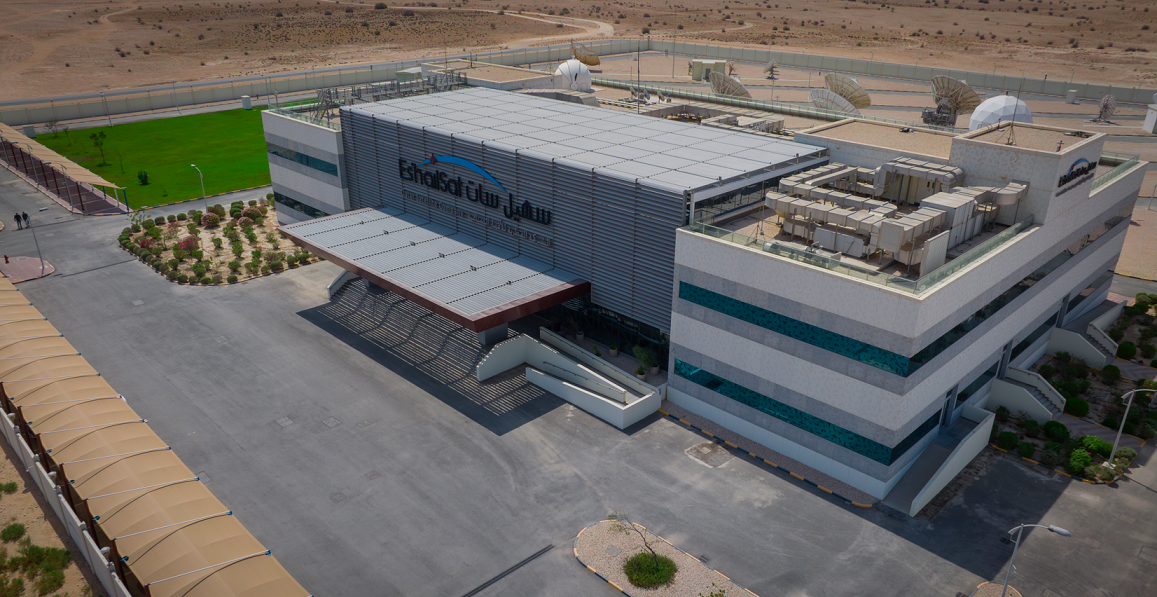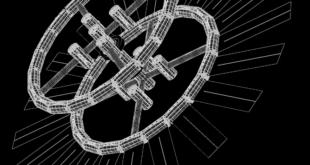
SpaceWatch.Global CEO and Publisher Torsten Kriening interviewed Ali Al Kuwari, Es’hailSat’s President and CEO, about the plans and future of the Qatari satellite company.
Torsten Kriening (TK): What did Es’hailSat add to its service portfolio on the back of the FIFA World Cup 2022?
Ali Al Kuwari (ALK): Es’hailSat’s commitment to providing cutting-edge services was perhaps most evident during the FIFA 2022 World Cup hosted in Qatar. This monumental event drew millions of viewers from around the world, and Es’hailSat played a pivotal role in delivering live coverage of the tournament to audiences across the MENA region.
The company’s digital satellite news-gathering services were enhanced to cater to the influx of live events taking place during the World Cup. With meticulous planning and a focus on robust infrastructure, Es’hailSat ensured that broadcasters had the tools and support needed to deliver real-time coverage of this global spectacle. The flawless transmission of live feeds and real-time updates to viewers showcased Es’hailSat’s unwavering dedication to delivering world-class broadcasting solutions.
TK: Does Es’hailSat continue to see satellite broadcasting playing a vital role in how content is consumed?
ALK: Yes. Satellite broadcasting continues to be vital to content consumption because Internet delivery, especially the last mile, is not uniform in its ability to provide quality of service and consistency in viewing experience to the end user. A lot depends on the number of active users, the size of the Internet pipe, and the overall content delivery mechanism all of which have too many moving parts for any one player to control completely. This is especially true in regions where a large segment of the population lives outside the urban areas where satellite broadcasting continues to be the most cost-effective way to provide a high-quality signal to the maximum number of viewers.
TK: What are some of the key enabling technologies for satellite broadcasting today, and what is Es’hailSat focused on?
ALK: Some of the key enabling technologies for satellite broadcasting today are those that enable content creators to get their libraries out to viewers in the form of channels and streams in the fastest and most cost-competitive manner. Further to this objective, Es’hailSat has recently launched its Playout & Media Services offering which combines the long-standing legacy of Es’hailSat’s satellite distribution and contribution platforms, together with the most advanced Playout solutions that enable TV channels to be deployed, rapidly from a one-stop-shop solution thus providing peace of mind to the content creators with maximum audience reach.
TK: What new launches have taken place on Es’hailSat’s satellites in the recent past?
ALK: Es’hailSat’s remarkable journey of innovation and expansion continues with the successful launch of three new TV channels in the past few months: Bedaya TV, Majan TV, and Salam TV catering to genres such as Reality TV, cultural programming, and infotainment. These additions to the satellite company’s portfolio not only enrich the content offerings available to viewers across MENA but also reinforce Es’hailSat’s status as a preferred partner for broadcasters in the region.
The ability to onboard new channels onto our satellites is a testament to Es’hailSat’s commitment to providing a robust and reliable platform for broadcasters to reach their audiences. These channels join a growing family of broadcasters who trust Es’hailSat to facilitate their content delivery, further solidifying the company’s reputation and led to Es’hailSat being awarded the Satellite Service Provider of the Year 2023 at the BroadcastPRO Middle East Summit & Awards held in Dubai on 8 November 2023.
TK: With companies like SpaceX, Amazon, and others growing rapidly how does a regional operator become a vital part of the overall eco-system?
ALK: Doing business in any space-based industry is hard, even if one considers the established geostationary satellite services segment. LEO systems are relatively young and CapEx refresh cycles are yet to play out fully which makes the recent gold rush of announcing constellations a trend that we believe needs to be approached with cautious optimism. A lot needs to be done before these systems become integrated into the 5G eco-system and the sheer volume of capital & technology advancements required make it an uphill climb for the companies involved. We bring our strengths of having worked with 4G and 5G networks across MENA to the table and that is our value addition. This is especially true when it comes to backhauling mobile services requiring high throughput services.
TK: Do you see satellite being effective where terrestrial cellular cannot reach? And what is your view of 5G Non-Terrestrial Networks (NTN)?
ALK: Traditionally satellites have extended the core network for cellular operators to remote and rural areas where terrestrial networks find it difficult to reach and maintain quality of service. Additionally, we are exploring new business models that involve Non-Geostationary satellite systems and Direct-to-Cell technologies to support cellular networks in extending their reach. 5G Non-Terrestrial Networks will complement our existing satellite infrastructure and provide a more efficient way to deliver high-speed data and voice services to remote locations. In addition to supporting IoT and M2M applications, they can also provide reliable means of communication in disaster-affected areas. They will be relevant to our business model going forward as the applications mentioned above are part of our growing portfolio of services.
TK: Es’hailSat has grown well over the past few years. What is the strategy to maintain this growth in coming years?
ALK: We are very much a GEO operator and will continue to support our broadcast, telecommunications, and government customers with our two satellites in GEO orbit. At Es’hailSat, we are firm believers in the fact that Internet connectivity is now as basic a need as electricity or water supply. Wherever terrestrial connectivity options stop is where the role of satellite technologies begins, and that is where Es’hailSat’s services come in. Be it cellular backhaul, VSAT networking, or even consumer broadband, we have the capabilities to support those companies that are looking to provide these services across the Middle East and North Africa today and across the globe very soon. We are also working on incorporating into our portfolio the latest advancements in technology, including Cloud services, Mobility, and Telecommunications services, and tailoring these to the needs of verticals such as Maritime, Mobility, and Energy.
TK: What kind of partnerships does Es’hailSat have and what is planned for the future?
ALK: We have multiple partnerships, such as those with BridgeComm for optical ground station, terminal and antenna, Inmarsat for MSS services and with technology providers, such as iDirect, Comtech etc., for enhancing our end-to-end service provisioning, etc. At this point, the global satellite industry is in a state of flux, with multiple low-Earth orbit constellations at various stages of their launch, each looking to provide global broadband connectivity. We are studying each of these projects closely and evaluating all possible options to enhance our future capabilities as a satellite operator. We also have sales partners such as AXESS, TMC, and others and channel partners in various geographies that help expand our presence across the MENA region. As Qatar’s satellite operator of choice, we bring tremendous value to any partnership and can provide the local and regional expertise that these global companies need to build a sustainable business in the region.
TK: What are some of the features of Es’hailSat’s facilities in Doha, Qatar?
ALK: Es’hailSat’s pursuit of excellence extends beyond the sky and on the ground with its state-of-the-art Teleport facility. Spanning an impressive 50,000 square meters, this facility is a technological marvel that embodies the capabilities of complementing satellite communications with ground infrastructure. Equipped with the space for building cutting-edge studios, ample room for equipment hosting, and top-tier uplinking and downlinking services, the Teleport facility is strategically positioned for EMEA coverage in Doha, Qatar.
This facility plays a pivotal role in catering to millions of viewers across MENA by ensuring uninterrupted satellite connectivity. It serves as the backbone for the distribution of content via Es’hailSat’s two leading satellites, Es’hail-1 and Es’hail-2 at 25.5/26 East hotspot. The result is a flawless, uninterrupted broadcast experience for viewers, reinforcing Es’hailSat’s reputation as a company that goes above and beyond to meet the needs of its clients and audiences alike.
TK: How does Es’hailSat address the growing demand and face challenges in evolving technology for reliable connectivity, particularly for remote and underserved areas?
ALK: At Es’hailSat we are firm believers in the fact that Internet connectivity is now as basic a need as electricity or water supply. Most countries have already recognized the availability of quality Internet as a utility that has a direct impact on GDP growth. Wherever terrestrial connectivity options stop is where the role of satellite technologies begins. And that is where Es’hailSat’s services to telecommunication companies come in. Both businesses and individuals have realized that their sustenance would not have been possible had it not been for the ability to log in to their workplaces or stay connected with family and friends via every available means of connectivity. Satellite, cellular, and fiber telecommunications have become the backbone of the economy, and Governments worldwide are investing in infrastructure to ensure that their populations remain connected irrespective of their location. Since our inception in 2010, Es’hailSat has leveraged industry-wide partnerships to bring the best of what is available globally to MENA’s ICT infrastructure.
TK: In what ways do Es’hailSat’s teleport and VSAT services improve connectivity and tech needs in sectors like telecommunications, government services, and maritime industries across the MENA region?
ALK: Es’hailSat’s 50,000 sqm teleport facility located outside Doha complements our satellite network comprising of two co-located satellites Es’hail-1 and Es’hail-2 at 25.5/26 degrees East. Together they ensure cost-effectiveness and enable Es’hailSat to offer end-to-end service to end-users with minimal overheads. Be it cellular backhaul or VSAT networking or maritime, we have the capabilities to support those companies who are looking for these services across the Middle East and North Africa. With regards to VSAT services, Es’hailSat has signed many strategic connectivity partnerships, some to offer enhanced VSAT support services in the Maritime segment while others to cater to communications infrastructure required for vessels at sea. One noteworthy example is the successful proof-of-concept that was completed using low-profile flat panel terminals for the maritime environment using the Es’hail-1 satellite.
TK: How does Es’hailSat address environmental sustainability and responsible satellite operations?
ALK: Es’hailSat’s teleport facilities are built using state-of-the-art and environmentally responsible materials that ensure that the impact on the environment around the teleport is minimized. When it comes to future satellites and spacecraft technology, the trend is towards the use of electric propulsion which is significantly more environmentally friendly. Together with our satellite manufacturing partners we are exploring the use of this technology for our future satellite missions. Furthermore, Environmental and Governance best practices are a part of our company’s long-term strategy and going forward these initiatives will only become increasingly important in order to build a sustainable long-term business.
TK: As security is the top key in today’s business, how does Es’hailSat ensure security and privacy for its customers?
ALK: Es’hailSat has been providing MENA’s Government and Enterprise customers with end-to-end satellite services for over a decade. These include fully encrypted, secure, fixed & mobile communications, anti-jamming capabilities as well as robust & reliable broadcasting services catering to audiences across the Middle East and North Africa. The security and independence of services provided by Es’hailSat helped broadcasters stay on air even during diplomatic and financial pressures and boycotts. This also helps VIPs and state agencies to remain connected securely both within Qatar and within the region.
TK: What are some of the new technology services that Es’hailSat is observing keenly?
ALK: The world is heading towards economies driven by artificial intelligence, neural networks, and the Internet of Things, all of which can only be enabled by robust telecommunications and IT infrastructure. Therefore, it is critical for these sectors, including satellite services, to build a culture of innovation and continuous development to be able to cater to these demands. With Qatar becoming a powerhouse of talent and technological prowess in the Middle East, advanced satellite services will help ensure that the economy of the country has the tools that it needs to grow from strength to strength.

Ali Al-Kuwari is the President and Chief Executive Officer (CEO) of Es’hailSat. A strategic leader with a progressive career of 20+ years in guiding and directing an enterprise through substantial resource management by utilizing strong and effective strategic leadership. Prior to his appointment at Es’hailSat, Mr. Al-Kuwari was the Assistant Secretary General at ict Qatar. He has also held the position of Finance Director at ict Qatar and was a member of the organization’s management team overseeing the strategic investment in the satellite initiative which became Es’hailSat. He joined ict Qatar in 2004 following senior financial positions with Ras Gas and the Ministry of Finance. Mr. Al Kuwari has a Bachelor’s degree in Business Administration and a Master’s degree in Financial Analysis.
 SpaceWatch.Global An independent perspective on space
SpaceWatch.Global An independent perspective on space




